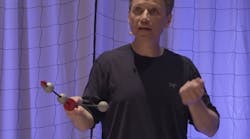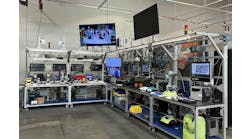Engelberger Robotics Award Honoree Talks RoboEarth
Raffaello D’Andrea is one of the founders of Kiva Systems, which was purchased by Amazon in 2012. He now is professor of dynamic systems and control at the Swiss Federal Institute of Technology (ETH) in Zurich, Switzerland.
On March 23 in Chicago, Raffaello D’Andrea was honored by the Robotics Industries Association and receive the Engelberger Robotics Award, named for Joseph F. Engelberger, the Father of Robotics. The awards ceremony was held in conjunction with Automate 2015, a conference and exhibition held at Chicago’s McCormick Place.
D’Andrea is one of the founders of Kiva Systems, which was purchased by Amazon in 2012. He now is professor of dynamic systems and control at the Swiss Federal Institute of Technology (ETH) in Zurich, Switzerland.
We spoke to D'Andrea prior to the Engelberger Robotics Award event, discussing various topics ranging from the public perception of robots, younger generations' interest in STEM, the future of cybersecurity and more.
CD: What does the Engelberger Award symbolize to you, in terms of achievement or recognition?
D’Andrea: It is the most prestigious award in robotics and it's an honor to be recognized by your peers and, for me especially, since the award I received is in the technology category, which is unusual for someone in academia to receive in that category it's even more of an honor for me.
CD: Lower costs and easier programming have set robotics on a course for becoming more component-like in larger machine applications. And yet Robocup is aspiring to field a team that can defeat the World Cup champions by 2050. Can you talk a little about where the public perception and the industrial perception of robots intersect?
D’Andrea: Just in general, the public perception of robots is very different than what is really possible in an industrial setting. There are a couple of reasons for that. One: movies, books and popular articles about robots really emphasize future capabilities and more along the line of what could be done as opposed to what can be done now or even this is what can be done in the future, but reliably.
Along those lines, anyone can make a video showing a robot doing something cool, but it's never clear how repeatable or robust what they're seeing on the video is. So, the public has this general misconception about what is possible to do reliably and in a robust way, which is, of course, what industry cares about. It doesn't care about doing it once out of 100 times or that it needs an army of people to set up. They want this thing to be inexpensive, viable, robust, easy to reconfigure, and unfortunately, that is not as sexy to the public.
There is this wide misconception and it's always existed, and I think it will continue to exist.
I think the key points are that movies use special effects and they give people the wrong idea of what's possible. But, even when special effects are not used, people are only seeing what could be done once. There's no indication of how reliable, how robust it is and how economically viable it is. Plus, how automated it really is. All of those things cause a disconnect. It's incidentally one of the reasons we like to do live demonstrations of things we post online. We also like to do road shows where we bring our robots out to the audience when we give presentations and give talks and it's for that very reason—so we really stay true to what is possible, robust and reliable, not just an exercise that may not have any meaning.
The main motivation that we do this for is to make sure we are working on problems and the solutions we come to for problems are reliable, and that's why there is a much bigger chance that the things we do will transition into the real world. We constrain ourselves to do things that we have to demonstrate in front of hundreds or thousands of people.
CD: The most recent Microsoft study, Cyberspace 2025, indicates that STEM students of the future will come from countries such as Morocco, Saudi Arabia, Kenya, Peru and Guatemala. Why would younger generations in smaller, emerging economies be more attracted to STEM curricula in the future?
D’Andrea: There's a couple of factors. Fortunately now, because of the Internet, anyone can access high-quality course material online. That means it's much easier for these folks in smaller, emerging economies to get a good and solid education. Plus, there are a lot of activities to educate these students, too. That's the supply side of it—it's easier for them to get the education they couldn't get in the past.
Then, there's also the demand issue. Folks in the western world, the really talented ones, get wooed into going into banking or finance simply because there's just ridiculous amounts of monies involved because of the way our economic system is set up. They're filling a void that western societies are creating because of the ability to make large amounts of money in other areas.
CD: Are the PLC’s days numbered? With embedded or PC-based controls continuing to gain ground, are there still applications in which the PLC is still a better choice, or are they just legacy systems waiting to be replaced?
D’Andrea: There will always be a need for components that are ultra reliable, easy to set up and easy to certify. That's kind of what I view PLCs as. Of course, they will need to adapt to the changing times simply to improve, become less expensive, be easier to program, but there will always be a need for components that are like that.
It's not always about finding the cheapest solution, but something that is ultra-reliable, ultra-robust, easy to certify. I don't think that's ever going to go away.
CD: Vision, measurement and sensing devices have become almost ubiquitous. The Internet of Things, or Industry 4.0, has gained much attention, but can you please explain how RoboEarth fits into the equation? Is it even a model for how the IoT might function?
D’Andrea: I think RoboEarth could be a piece of it. RoboEarth was a demonstrator of what you could do if robots shared information. Now, this information comes in many forms. For example, one of the things we demonstrated was if robots could share mapping information so they could collectively learn and map an environment faster than they could on their own. Also, if a robot entered a room, for example, they wouldn't have to re-map it. They could just query the database, and they would have a pretty good idea of the things that are around them. It would make them higher-performing.
The other thing we explored in RoboEarth is how to share knowledge. Right now, if we create a machine, a robot, when we turn it off and decommission it, all the things—if it's an adaptive machine—that it has learned and adapted are lost. One of the interesting things we've tried to adapt in RoboEarth was the following idea: If you could create a robot that, on its own, could take a year to learn how to do something you would never deploy it. No one would buy it. But if you had thousands of these robots that could collectively learn how to do something in a day, then all of a sudden it becomes much more viable.
This idea of thousands of machines sharing information opens up the design space of what is economically feasible. That was one of the things we focused on in RoboEarth.
I think this idea of machines sharing information so they can do their jobs better is a solid idea. Also, the idea of off-loading computation to the cloud just makes a lot of sense depending on what the machine is. I think we're going to see more and more of that.
CD: Cybersecurity is a topic that everyone talks about, but few understand, primarily because the predators keep adapting and changing, requiring the same from security measures. In your opinion, where are the logical places for defense in depth, or is there a larger-scale initiative that should be pursued?
D’Andrea: First of all, let me say there is a lot of great research going on in this area. But, it's the usual thing: I don't think we're going to see really concerted activity in this area until something large-scale happens. Then people will wake up and say, "Hey, this is a problem. We need to create the right regulation and the right standard so when we deploy these systems we'll have the best knowledge of all these great research baked into protocols and certification requirements to mitigate these types of things from happening." But, I'm skeptical that's going to happen in a preemptive way. I think we're going to have to wait for something big to happen before we wake up.

Leaders relevant to this article:




